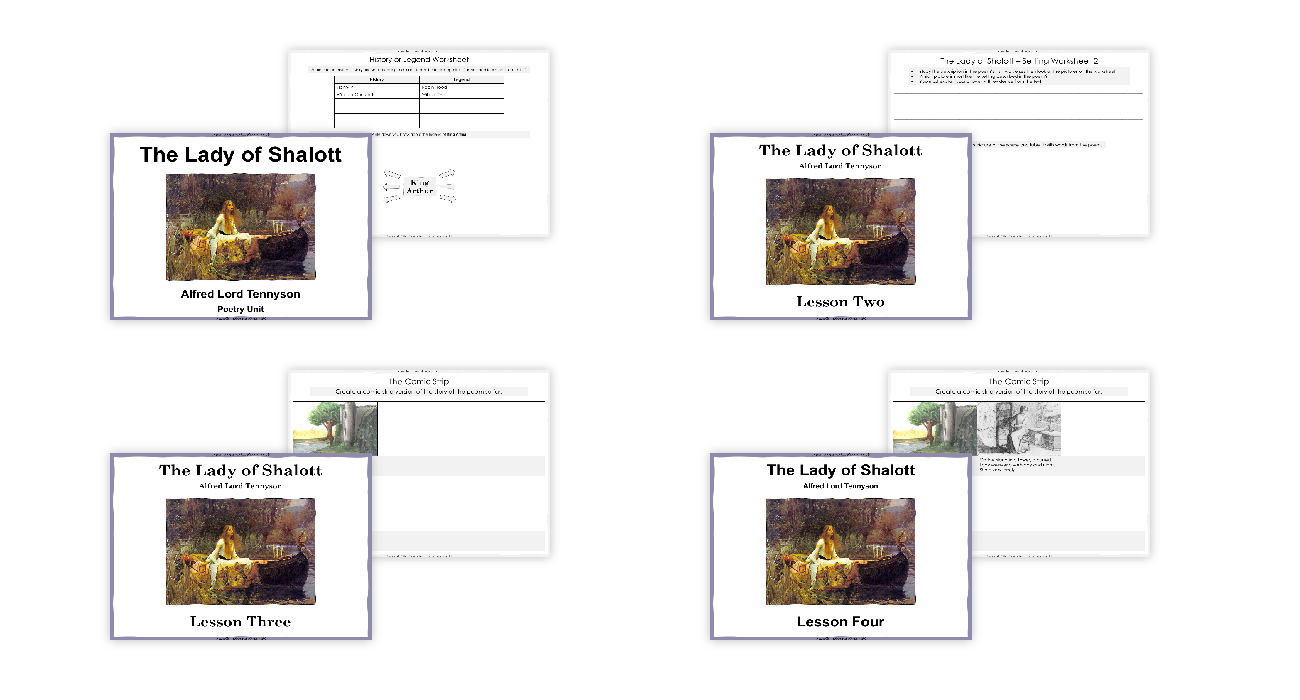The Lady of Shalott by Alfred Tennyson
Unit
English
Year 5 - Year 6
Teacher of Primary
English Unit Description
This unit of work is based on the 1842 version of the poem The Lady of Shalott and covers many key areas required by the National Curriculum. It includes a range of activities for students of all abilities. Contents include: - Activities to develop general knowledge and understanding of the poems and narrative - Studying the use of setting and descriptive language - Analysing the characters of the Lady of Shalott and Sir Lancelot - Comprehension questions (with answers) to assess children's understanding as you go - Studying metaphors, onomatopoeia and pathetic fallacy and lots more.
Unit contents
Overview Documents
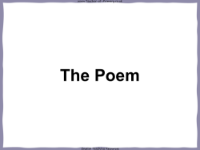
The Poem Powerpoint
Resource
English
Y5 - Y6
This unit of work is based on the 1842 version of the poem The Lady of Shalott and covers many key areas required by the National Curriculum. It includes a range of activities for students of all abilities. Contents include: - Activities to develop general knowledge and understanding of the poems and narrative - Studying the use of setting and descriptive language - Analysing the characters of the Lady of Shalott and Sir Lancelot - Comprehension questions (with answers) to assess children's understanding as you go - Studying metaphors, onomatopoeia and pathetic fallacy and lots more.
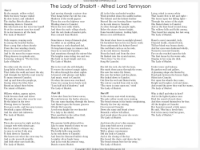
Poem (1 page)
Resource
English
Y5 - Y6
This unit of work is based on the 1842 version of the poem The Lady of Shalott and covers many key areas required by the National Curriculum. It includes a range of activities for students of all abilities. Contents include: - Activities to develop general knowledge and understanding of the poems and narrative - Studying the use of setting and descriptive language - Analysing the characters of the Lady of Shalott and Sir Lancelot - Comprehension questions (with answers) to assess children's understanding as you go - Studying metaphors, onomatopoeia and pathetic fallacy and lots more.
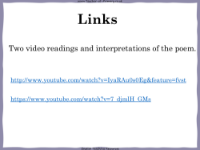
Links Powerpoint
Resource
English
Y5 - Y6
This unit of work is based on the 1842 version of the poem The Lady of Shalott and covers many key areas required by the National Curriculum. It includes a range of activities for students of all abilities. Contents include: - Activities to develop general knowledge and understanding of the poems and narrative - Studying the use of setting and descriptive language - Analysing the characters of the Lady of Shalott and Sir Lancelot - Comprehension questions (with answers) to assess children's understanding as you go - Studying metaphors, onomatopoeia and pathetic fallacy and lots more.
Lessons
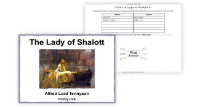
1. The Legend of King Arthur
Lesson
English
Y5
This unit of work is based on the 1842 version of the poem The Lady of Shalott and covers many key areas required by the National Curriculum. It includes a range of activities for students of all abilities. Contents include: - Activities to develop general knowledge and understanding of the poems and narrative - Studying the use of setting and descriptive language - Analysing the characters of the Lady of Shalott and Sir Lancelot - Comprehension questions (with answers) to assess children's understanding as you go - Studying metaphors, onomatopoeia and pathetic fallacy and lots more.
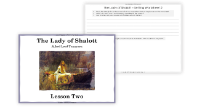
2. Establishing Setting
Lesson
English
Y5
This unit of work is based on the 1842 version of the poem The Lady of Shalott and covers many key areas required by the National Curriculum. It includes a range of activities for students of all abilities. Contents include: - Activities to develop general knowledge and understanding of the poems and narrative - Studying the use of setting and descriptive language - Analysing the characters of the Lady of Shalott and Sir Lancelot - Comprehension questions (with answers) to assess children's understanding as you go - Studying metaphors, onomatopoeia and pathetic fallacy and lots more.
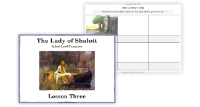
3. Describing Lady Shalott
Lesson
English
Y5
This unit of work is based on the 1842 version of the poem The Lady of Shalott and covers many key areas required by the National Curriculum. It includes a range of activities for students of all abilities. Contents include: - Activities to develop general knowledge and understanding of the poems and narrative - Studying the use of setting and descriptive language - Analysing the characters of the Lady of Shalott and Sir Lancelot - Comprehension questions (with answers) to assess children's understanding as you go - Studying metaphors, onomatopoeia and pathetic fallacy and lots more.
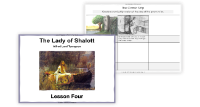
4. Character Analysis
Lesson
English
Y5
This unit of work is based on the 1842 version of the poem The Lady of Shalott and covers many key areas required by the National Curriculum. It includes a range of activities for students of all abilities. Contents include: - Activities to develop general knowledge and understanding of the poems and narrative - Studying the use of setting and descriptive language - Analysing the characters of the Lady of Shalott and Sir Lancelot - Comprehension questions (with answers) to assess children's understanding as you go - Studying metaphors, onomatopoeia and pathetic fallacy and lots more.
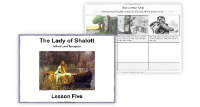
5. Sir Lancelot
Lesson
English
Y5
This unit of work is based on the 1842 version of the poem The Lady of Shalott and covers many key areas required by the National Curriculum. It includes a range of activities for students of all abilities. Contents include: - Activities to develop general knowledge and understanding of the poems and narrative - Studying the use of setting and descriptive language - Analysing the characters of the Lady of Shalott and Sir Lancelot - Comprehension questions (with answers) to assess children's understanding as you go - Studying metaphors, onomatopoeia and pathetic fallacy and lots more.
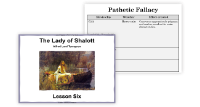
6. Pathetic Fallacy
Lesson
English
Y5
This unit of work is based on the 1842 version of the poem The Lady of Shalott and covers many key areas required by the National Curriculum. It includes a range of activities for students of all abilities. Contents include: - Activities to develop general knowledge and understanding of the poems and narrative - Studying the use of setting and descriptive language - Analysing the characters of the Lady of Shalott and Sir Lancelot - Comprehension questions (with answers) to assess children's understanding as you go - Studying metaphors, onomatopoeia and pathetic fallacy and lots more.
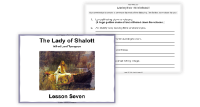
7. Methaphors
Lesson
English
Y5
This unit of work is based on the 1842 version of the poem The Lady of Shalott and covers many key areas required by the National Curriculum. It includes a range of activities for students of all abilities. Contents include: - Activities to develop general knowledge and understanding of the poems and narrative - Studying the use of setting and descriptive language - Analysing the characters of the Lady of Shalott and Sir Lancelot - Comprehension questions (with answers) to assess children's understanding as you go - Studying metaphors, onomatopoeia and pathetic fallacy and lots more.
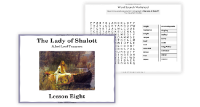
8. Demonstrating Understanding
Lesson
English
Y5
This unit of work is based on the 1842 version of the poem The Lady of Shalott and covers many key areas required by the National Curriculum. It includes a range of activities for students of all abilities. Contents include: - Activities to develop general knowledge and understanding of the poems and narrative - Studying the use of setting and descriptive language - Analysing the characters of the Lady of Shalott and Sir Lancelot - Comprehension questions (with answers) to assess children's understanding as you go - Studying metaphors, onomatopoeia and pathetic fallacy and lots more.
Additional Resources
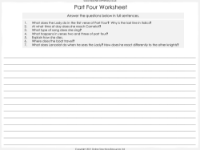
Part Four Worksheet
Resource
English
Y5 - Y6
This unit of work is based on the 1842 version of the poem The Lady of Shalott and covers many key areas required by the National Curriculum. It includes a range of activities for students of all abilities. Contents include: - Activities to develop general knowledge and understanding of the poems and narrative - Studying the use of setting and descriptive language - Analysing the characters of the Lady of Shalott and Sir Lancelot - Comprehension questions (with answers) to assess children's understanding as you go - Studying metaphors, onomatopoeia and pathetic fallacy and lots more.
Unit contents
Overview Documents

The Poem Powerpoint
Resource
English
Y5 - Y6
This unit of work is based on the 1842 version of the poem The Lady of Shalott and covers many key areas required by the National Curriculum. It includes a range of activities for students of all abilities. Contents include: - Activities to develop general knowledge and understanding of the poems and narrative - Studying the use of setting and descriptive language - Analysing the characters of the Lady of Shalott and Sir Lancelot - Comprehension questions (with answers) to assess children's understanding as you go - Studying metaphors, onomatopoeia and pathetic fallacy and lots more.

Poem (1 page)
Resource
English
Y5 - Y6
This unit of work is based on the 1842 version of the poem The Lady of Shalott and covers many key areas required by the National Curriculum. It includes a range of activities for students of all abilities. Contents include: - Activities to develop general knowledge and understanding of the poems and narrative - Studying the use of setting and descriptive language - Analysing the characters of the Lady of Shalott and Sir Lancelot - Comprehension questions (with answers) to assess children's understanding as you go - Studying metaphors, onomatopoeia and pathetic fallacy and lots more.

Links Powerpoint
Resource
English
Y5 - Y6
This unit of work is based on the 1842 version of the poem The Lady of Shalott and covers many key areas required by the National Curriculum. It includes a range of activities for students of all abilities. Contents include: - Activities to develop general knowledge and understanding of the poems and narrative - Studying the use of setting and descriptive language - Analysing the characters of the Lady of Shalott and Sir Lancelot - Comprehension questions (with answers) to assess children's understanding as you go - Studying metaphors, onomatopoeia and pathetic fallacy and lots more.
Lessons

1. The Legend of King Arthur
Lesson
English
Y5
This unit of work is based on the 1842 version of the poem The Lady of Shalott and covers many key areas required by the National Curriculum. It includes a range of activities for students of all abilities. Contents include: - Activities to develop general knowledge and understanding of the poems and narrative - Studying the use of setting and descriptive language - Analysing the characters of the Lady of Shalott and Sir Lancelot - Comprehension questions (with answers) to assess children's understanding as you go - Studying metaphors, onomatopoeia and pathetic fallacy and lots more.

2. Establishing Setting
Lesson
English
Y5
This unit of work is based on the 1842 version of the poem The Lady of Shalott and covers many key areas required by the National Curriculum. It includes a range of activities for students of all abilities. Contents include: - Activities to develop general knowledge and understanding of the poems and narrative - Studying the use of setting and descriptive language - Analysing the characters of the Lady of Shalott and Sir Lancelot - Comprehension questions (with answers) to assess children's understanding as you go - Studying metaphors, onomatopoeia and pathetic fallacy and lots more.

3. Describing Lady Shalott
Lesson
English
Y5
This unit of work is based on the 1842 version of the poem The Lady of Shalott and covers many key areas required by the National Curriculum. It includes a range of activities for students of all abilities. Contents include: - Activities to develop general knowledge and understanding of the poems and narrative - Studying the use of setting and descriptive language - Analysing the characters of the Lady of Shalott and Sir Lancelot - Comprehension questions (with answers) to assess children's understanding as you go - Studying metaphors, onomatopoeia and pathetic fallacy and lots more.

4. Character Analysis
Lesson
English
Y5
This unit of work is based on the 1842 version of the poem The Lady of Shalott and covers many key areas required by the National Curriculum. It includes a range of activities for students of all abilities. Contents include: - Activities to develop general knowledge and understanding of the poems and narrative - Studying the use of setting and descriptive language - Analysing the characters of the Lady of Shalott and Sir Lancelot - Comprehension questions (with answers) to assess children's understanding as you go - Studying metaphors, onomatopoeia and pathetic fallacy and lots more.

5. Sir Lancelot
Lesson
English
Y5
This unit of work is based on the 1842 version of the poem The Lady of Shalott and covers many key areas required by the National Curriculum. It includes a range of activities for students of all abilities. Contents include: - Activities to develop general knowledge and understanding of the poems and narrative - Studying the use of setting and descriptive language - Analysing the characters of the Lady of Shalott and Sir Lancelot - Comprehension questions (with answers) to assess children's understanding as you go - Studying metaphors, onomatopoeia and pathetic fallacy and lots more.

6. Pathetic Fallacy
Lesson
English
Y5
This unit of work is based on the 1842 version of the poem The Lady of Shalott and covers many key areas required by the National Curriculum. It includes a range of activities for students of all abilities. Contents include: - Activities to develop general knowledge and understanding of the poems and narrative - Studying the use of setting and descriptive language - Analysing the characters of the Lady of Shalott and Sir Lancelot - Comprehension questions (with answers) to assess children's understanding as you go - Studying metaphors, onomatopoeia and pathetic fallacy and lots more.

7. Methaphors
Lesson
English
Y5
This unit of work is based on the 1842 version of the poem The Lady of Shalott and covers many key areas required by the National Curriculum. It includes a range of activities for students of all abilities. Contents include: - Activities to develop general knowledge and understanding of the poems and narrative - Studying the use of setting and descriptive language - Analysing the characters of the Lady of Shalott and Sir Lancelot - Comprehension questions (with answers) to assess children's understanding as you go - Studying metaphors, onomatopoeia and pathetic fallacy and lots more.

8. Demonstrating Understanding
Lesson
English
Y5
This unit of work is based on the 1842 version of the poem The Lady of Shalott and covers many key areas required by the National Curriculum. It includes a range of activities for students of all abilities. Contents include: - Activities to develop general knowledge and understanding of the poems and narrative - Studying the use of setting and descriptive language - Analysing the characters of the Lady of Shalott and Sir Lancelot - Comprehension questions (with answers) to assess children's understanding as you go - Studying metaphors, onomatopoeia and pathetic fallacy and lots more.
Additional Resources

Part Four Worksheet
Resource
English
Y5 - Y6
This unit of work is based on the 1842 version of the poem The Lady of Shalott and covers many key areas required by the National Curriculum. It includes a range of activities for students of all abilities. Contents include: - Activities to develop general knowledge and understanding of the poems and narrative - Studying the use of setting and descriptive language - Analysing the characters of the Lady of Shalott and Sir Lancelot - Comprehension questions (with answers) to assess children's understanding as you go - Studying metaphors, onomatopoeia and pathetic fallacy and lots more.
Unlimited access to 30,000+ resources
All subjects
National Curriculum Coverage
Award-winning content
This website uses cookies to enhance the user experience.
To get more information about these cookies check our
Hey! It looks like you're in the United States.
Stay on the UK site
Switch to the US site

